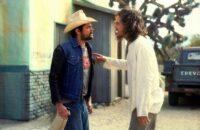“On-Screen, Off-Screen” is our monthly film series created to showcase a more personal retrospective about some of our favourite filmmakers. Each month, one 25YL staffer will choose one of their own favourite filmmakers—be it a director or performer or writer or composer or production designer, etc—and will analyse what it is about their on-screen work that they love, and how they’ve been influenced/inspired by them off-screen either personally or creatively or artistically. Maybe one of us will write about the entire filmography of a director, or someone might choose an actor associated with playing a certain role multiple times, or maybe there’s that one soundtrack by a composer that gets them every time. This month sees Valerie Thompson reflecting on the magical experience of seeing Steven Spielberg’s E.T. the Extra-Terrestrial for the first time. Enjoy!
You’ll probably open this piece expecting a long-winded retrospective of Steven Spielberg’s contributions to cinema—this is not one of those kinds of articles. Instead, allow me to tell a story that is a testament to the director’s movies and the power of film itself. This tale starts in the most unlikely of places, a run-down mall cinema in the heart of small town USA…
It was a town like any other, full of unfulfilled possibilities and unrealized dreams for those who never quite made it out. A young child in this place had two options: live in poverty or hope your family had enough to give you a mildly comfortable life. The richest of the community—who inherently looked down on everyone else with perceived disgust—took great pride in opportunities realized off the backs of others. Children who called this modern-day socioeconomic thrill ride home had one chance to escape—dream. Of course, there were those who already embraced the notion of going in with mom and dad to extend another person’s sense of business prowess. For everyone else, few select options offered the perfect way out. Books, sports, whatever it took to conjure the notions of a better life; they were open to it. Somewhere in all of this, the dreams reached a little girl who had seen and felt all too much in her fairly new life. Soaking up the visions radiating on TV screens, the scenarios proved to be so much more than what laid before her in the real world. One day a mother, overly stressed and severely overworked, made a decision to take this little one to the movies. Honestly, it could have been any film; though the mother tried to find something at least deemed kid-friendly. With the help of the girl’s ever-present and totally doting grandmother, an escape to the local cinema was planned for the family.
In this incarnation of the local shopping center, you walked through the mall before stumbling upon the cavernous theater. Its tan and beige walls were more than just unsettling; they gave you an impression that you were surrounded by a dullness that was inescapable. Past the posters for the upcoming fare—one of which particularly disturbed the child—the family moved onward unencumbered by the girl’s fears. Once inside that small theater, this young mind rationalized a hundred ways this could go; that’s when everything went dark and a light began to flicker. Right in front of her eyes, the screen was illuminated with coming attractions and quick commercials. To adults, it was standard fare; to the little girl, it was the greatest magic trick ever created.
The film playing that day just happened to be E.T. the Extra-Terrestrial. By now, everyone should be aware of the timeless story of Elliott and an alien finding friendship among a less than forgiving world. For a child still trying to understand their own place in an unwelcoming society, there was nothing better than thinking past the stars towards something bigger and better. It goes without saying that there was an instant connection between the girl and her alien friend on the screen that would even make Elliott jealous; this little viewer laughed, smiled, and cried, but her heart shattered when she thought the new friend had died. Anguished by the child’s cries, her mother whisked the little one off to the bathroom to allay fears and—without any knowledge of where the plot was going—promised that everything would be alright for the extraterrestrial visitor. After returning, both parent and child were happy to learn that E.T. was not only back, but on his way towards a family reunion.
Somewhere in these moments, that girl discovered a revelation hid between the frames of this family classic. It was a notion; a realization that she wanted to be a part of whatever was unfolding in front of her very eyes. No, not the story (though a few words with the alien would have been more than appreciated). It was the actual creation that glowed in front of her; the very idea that this magical medium was something more than the film playing out to its inevitable conclusion. Leaving the theater, it was all the child could speak of; that feeling that she wanted to stay there and be immersed in this strange creation.
After finally being pulled away from the beige dwelling that housed so many visions, the young one started to dream at a pace that would make even the most creative adults jealous. She begged for any piece of information available about not only the film but the medium itself. It was enough for her family to begin finding magazines or subscribing to publications that fed her quest. One day, while perusing a magazine, the girl’s mother showed her a story on the director who brought this curiosity to life. Accompanying the piece was a picture of E.T.’s director Steven Spielberg and the alien who was helping the film achieve cinematic immortality. It was explained to the little one that this man made the entire film happen—it was his vision that created the growing fascination. In a matter of moments, the picture was neatly torn from the pages and folded to the perfect dimensions. She reached for the transparent pink Hello Kitty box that followed her everywhere—this small square with pink tinted transparent sides held all of her important possessions at any moment. What was considered important constantly moved and shifted with current preoccupations or levels of significance; the only constant became this image that took a human and made them an idol.
The box went everywhere and saw probably everything a child could dream of. In the same spirit, Spielberg’s works were there as a guide along the way. What a teacher to have through life’s lesson. Indiana Jones showed what it meant to be a hero. The stories of Jaws and Jurassic Park taught the cruel truth that mother nature always wins (even when we think she doesn’t). He also created lessons for life that extended far beyond cinematic conventions with films like Schindler’s List, Saving Private Ryan, and The Color Purple. They showed what it meant to be a human—with all its frailties and complexities in full view.
Time went on, the child grew up, and the box found its place on a shelf. Never quite out of sight, it’s still there and still viewed with as much love as it was when it first found its way into a girl’s life. Through the good and the bad, it’s been the reminder that film has that power to change the world. You’ve probably guessed by now that the child was me and you’d be right. This box stands as a testament to why I began to love film and why I’ve been lucky enough to be involved with it in many forms. I don’t know if that would have happened without the one defining moment when I experienced film for the first time. Seeing what it could be through the eyes of Spielberg gave me possibilities as well as hope. It lit the spark of creativity, instead of pushing it away or discounting its importance.
I’ve rarely spoken of this story but found myself recalling it to an actor who worked with Spielberg on one of his most well-known films. He told me to tell this story—and here I am. It’s my journey through the gateway, and for that, I’m forever grateful.



